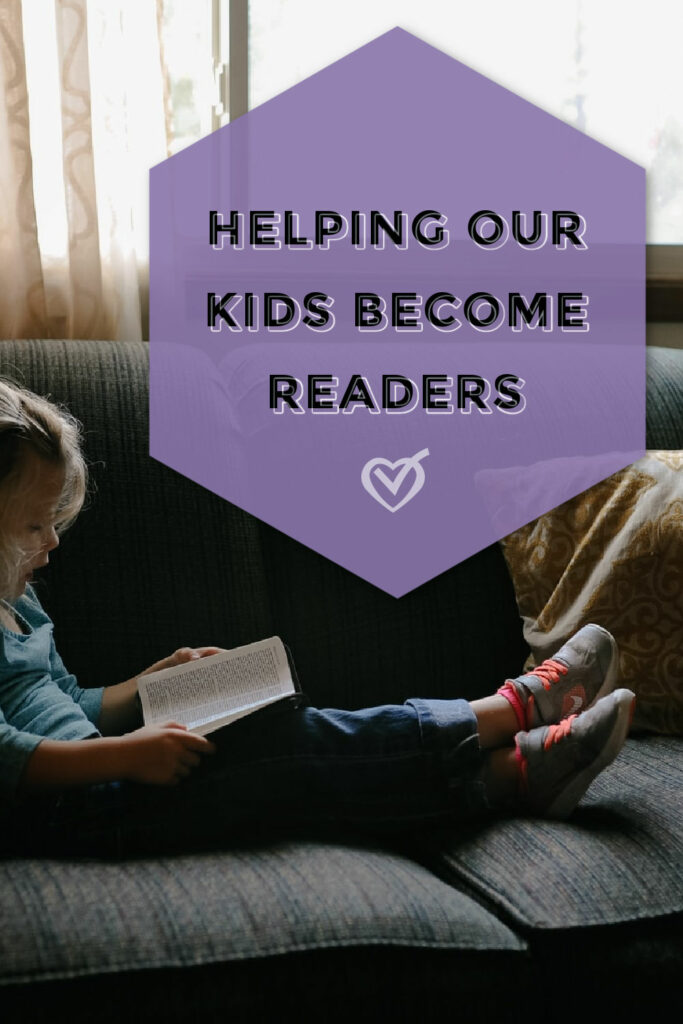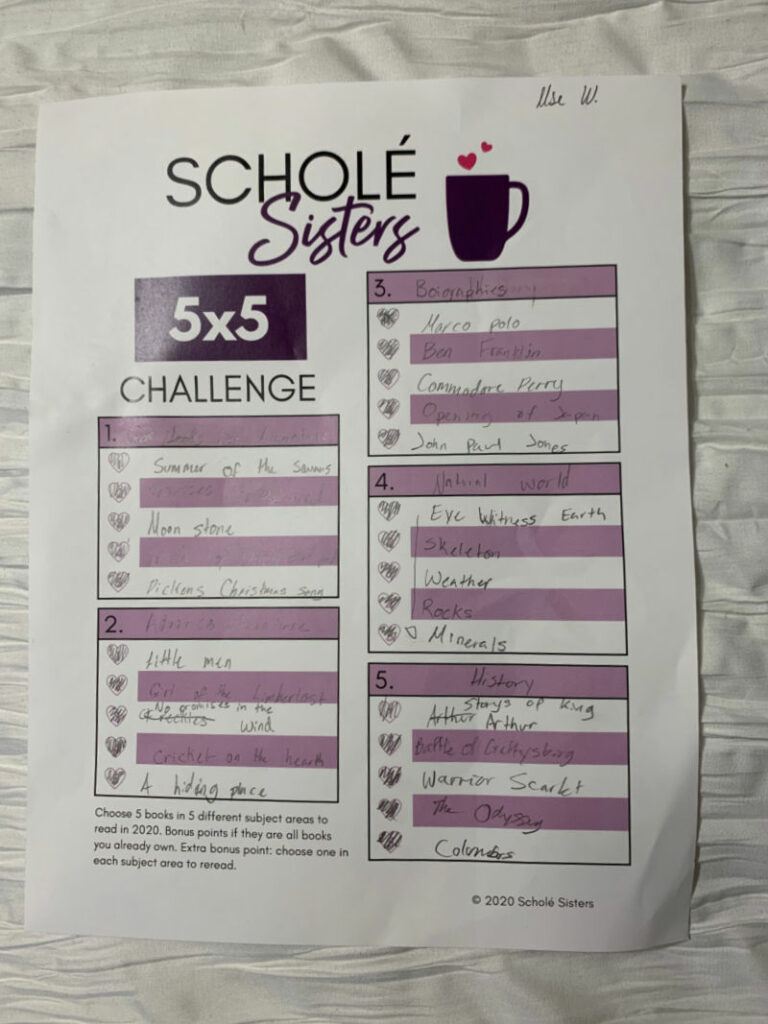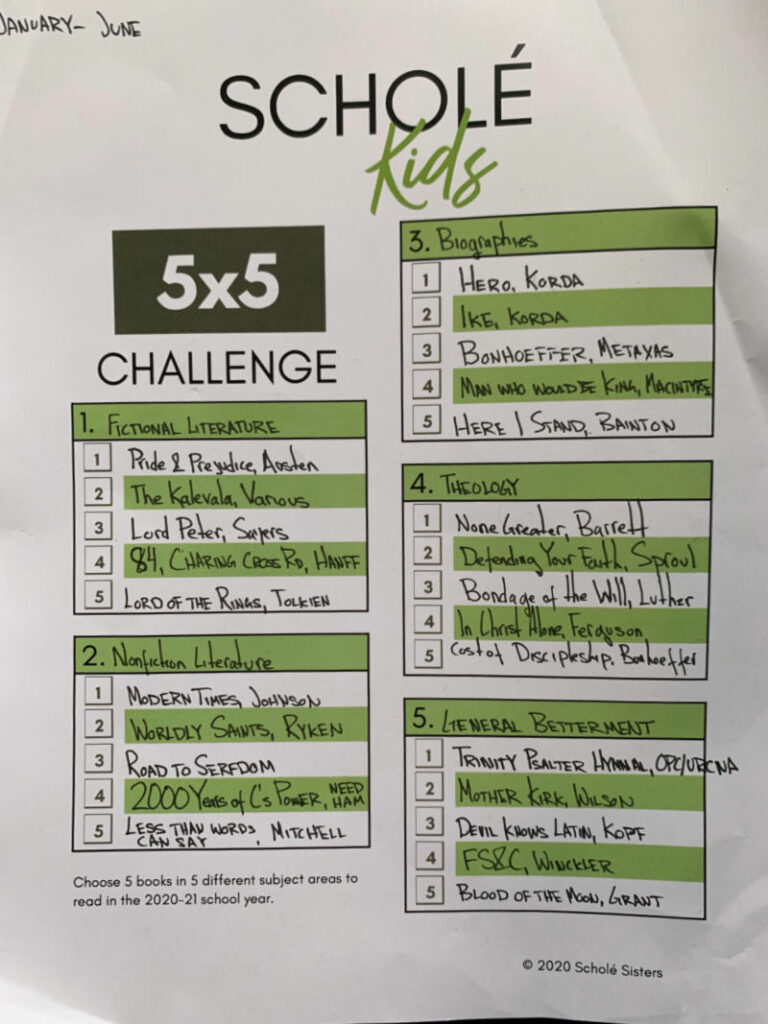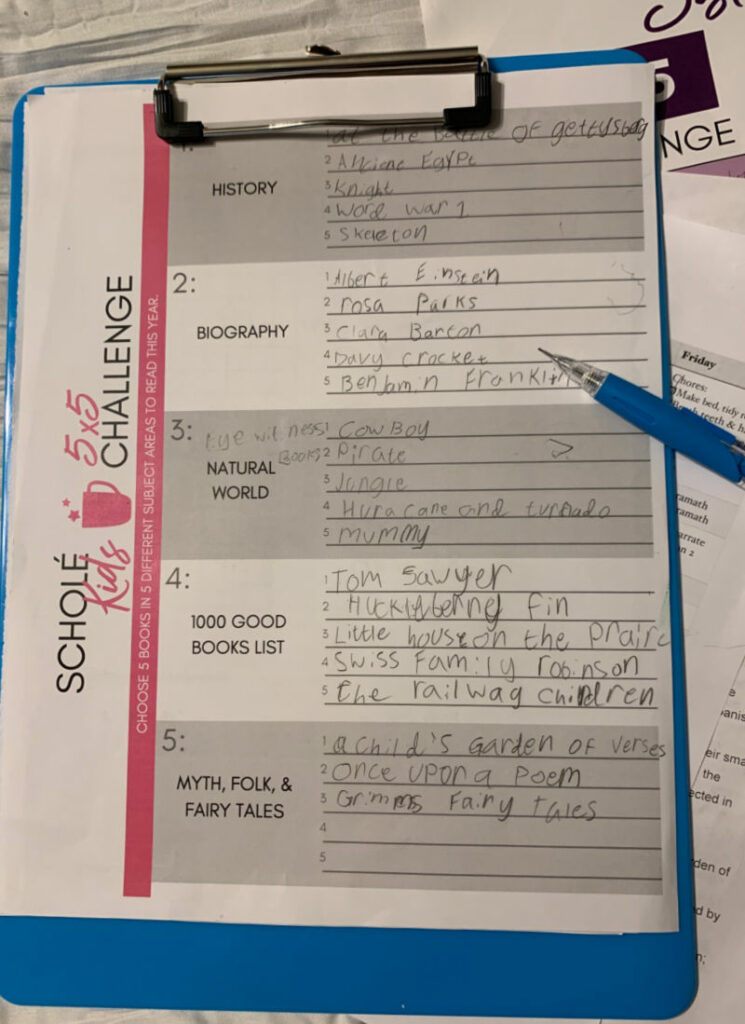
One of our goals as homeschool parents is not only to teach our kids to read, but also help them love to read.
Some are on board with this goal and therefore conclude we shouldn’t make our kids read, because that will kill the joy. They tend to suggest fun and easy books because how kids’ feel is their guide and immediate goal.
However, as classical educator’s, our kids’ future feelings are more important to us than their current feelings. We’re training, guiding, discipling their feelings, not catering to them. In principle, we ought to parent in books the same way we do in food: We don’t fear our kids won’t want to eat. We simply fix healthy meals and place them at the table in appropriate intervals. If our kids start getting picky, we don’t react by giving them only what they like: jelly beans and coke or even bread and jam.
We also don’t just let our kids forage as they will, if they will. Parenting is our job. Raising them up and showing them how is our job.
We can give our kids the resources, practices, and habits of broad, wide, interested and interesting readers.

My Dad Taught Me to Be a Reader
When I was a kid, homeschooled way before it was cool, I learned a lot more from life than I did from the Bible-verse-at-the-top worksheets I had to do every morning. I don’t mean that I learned math from making cookies. I mean I internalized and truly learned more from the way we lived, from what was prioritized, than from a chapter in a textbook.
One such prioritization was books. Yes, I had to do my textbook work. That was school and required. Then, the world was a cool place with all sorts of interesting possibilities and a library readily accessible with books about it all. Learning happened after school from library books – all the library books we could get.
From my dad I learned that life was interesting and there was always something new to learn. If you’re interested in something, or wonder about something, the path is clear:
- Go to the library.
- Check out five books on the topic.
- Read them.
My parents never had a single go-to guru. They took in catalogs and magazines from all sorts, bought books from those who sold any worth having, and kept their identity in their own family and their own local church, even though both were made up of people doing things differently.
Fast forward 30 years. I have interests. So I buy books. I know I want to read multiple perspectives and not just have “a guy” who gives me all the answers. So I buy lots of books.
I buy way more books than I read. But I promise I’m interested in what they say.
The Story of the 5×5 Challenge
Fast forward to the closing month of 2019. It’s resolution-writing time, and I had an abysmal reading year. I feel like I have to apologize to my book collection – No really, I am interested.
If you’re interested in something, get 5 books on the subject and read them.
The principle, the lifestyle, I was taught by example rather than precept came back to me and I resolved to read 5 books on the topics I am always buying books on: Theology, Education, Philosophy, History. Five books in four categories. Better make it five. I also need to read more fiction.
I have friends who read fifty or more books a year. Was it really worth making a reading goal that was less than 52, a book a week? 25 books in a year might not be impressive to many of my friends and colleagues, but it was more than double the number I read in 2019 and I’d be following a principled plan: Even if it was “only” 25, I’d have a better perspective on these 5 topics for deliberately choosing to read 5 books in each. It’d be more bang for my book-reading buck.
Fast-forward to 2021. I completed my 5×5 challenge on the evening of December 31st: just by-barely as my children would say, and not without adjustments along the way in which titles I read in those 5 categories. But it was a lot of thinking-bang for the reading-buck. The books talked to each other in ways I’d rarely experienced before. What I was reading made it into conversations I had in real life and gave me better educated perspectives on current events.
Education is the process of selling someone on books.

Rewind to when my husband (who was also homeschooled) and I first started discussing what we wanted our homeschool to look like.
We both noted that the things we truly learned and thought about and remembered came from the books we read on our own, not from assigned textbooks. So, we concluded, beyond not relying on textbooks, we also wanted to prioritize independent, broad reading.
I don’t think of my job as making sure we “cover” what we need to in school. My job is to open doors, train tastes, build appetites, and reserve space.
Where others judge by test results, I judge by whether or not kids pick up books in their spare time – and what kind of books those are.
Some kids need more accountability and structure and support than others.
Some kids need reading time scheduled and required. But that must be seen as a training wheel. Use it to get them going, and when they’re going, remove it because it will hinder more than it helps at that point.
Our goal in our homeschool is to raise lifelong learners, which means lifelong readers – the opposite of picky readers as well as non-readers.
Why the 5×5 Reading Challenge works for kids
The 5×5 challenge – like any reading challenge – helps both kids and grownups in the same way:
- It gives motivation and guidance. When you feel the excitement of the start of a new year or a new challenge (or both), and seize it, expressing it in a fun form, you can open your notebook and return to it when you stop feeling the draw. You’re paying your enthusiasm forward, making it easier to return to or at least act on in the future instead of simply losing momentum because your vision and excitement was never expressed in written form where you could see and remember.
- It shows progress. We feel more excited and motivated when we notice progress being made. Seeing the checked boxes or blanks being filled as we go reminds us that we’re really doing it, which helps us keep going. We gain traction by seeing our progress in a visibly tracked way.
- It allows you to join a community. A challenge like the 5×5 helps beyond just selecting books and working a plan because you’re also joining a community doing the same thing. Community builds momentum and motivation. Within your own home, you can also accomplish this by inviting another homeschooling family to do the challenge with you or even just by joining your kids and each working on your own challenge and sticking with it together.

The 5×5 challenge is unique among reading challenges – for both kids and grownups in several ways:
- It is flexible and personal. You choose both categories and titles. The form and structure helps you set up both for breadth and depth – 5 different categories to get out of a reading rut, but also 5 books in each to gain real depth and knowledge within that category.
- It is not genre or guru specific. Most reading challenges focus on fiction or on non-fiction. They focus on a single topic or a single issue or a single community goal. The 5×5 challenge is about stepping out of genre and author comfort zones – whatever yours happen to be.
- It is doable. Twenty-five books is not an overwhelming number. If reading twenty-five books seems like a lot, be sure to not choose tomes but briefer volumes. Finishing books increases momentum, so fill your challenge with books that will allow you to have the win of a strong finish, book by book, then before you know it, you’ll have the win of a completed challenge. And you’ll want to start over again.
The 5×5 challenge is great for kids in particular because it helps them exercise their own book-choosing muscles. Readers choose books and read them, they don’t wait for assignments. By having the child select the books, we are giving them the opportunity to build the habits of a reader. All new habits are uncomfortable at first, but it is practice that turns them into true habits. The feelings and comfort follow the habit.
Children – like adults – are more likely to pick up the book on their own if it’s a book of their own choosing. By using a challenge like this, we establish perimeters that set them up for successful choosing.
How to choose categories for your kids’ challenge
So then comes the category-choosing, which is where many begin to panic as to what “counts,” what “ought” to be chosen, and what is “good enough.”
If you can just get started in whatever way seems doable and exciting for you and your kids, it’s the right way. Over time, as your reading and book-selection muscles develop, you’ll be able to get more and more specific or broad or challenging.

You should start where you’re at, though, not where you want to end up.
In our homeschool, the 5×5 challenge takes the place of any kind of school-assigned “free reads.” Because all my kids are already able to and willing to read, because we have a large personal library to choose from, and because we’ve always been picky about entertainment options (no television shows and few movies means the kids’ taste is not trained for the fast and flashy), I specify these categories:
- History
- Biography
- Natural World
- 1000 Good Books List
- Myth/Fairy/Folk Tales
Within those categories, the kids all choose books from our own family library. The “1000 Good Books List” refers to think reading list from John Senior on what needs to be read before anyone is ready to really read with understanding and enjoyment any Great Book. Some of the categories are overlapping, and that’s ok. For example, if they had 6 biographies they wanted to read, 5 could go in the biography category and 1 could go in history. The 1000 Good Books List includes myth and fairy tales, which could go in either category.
After my kids finish their first 5×5 challenge with these categories, then I give them a blank one where they can choose their own categories. Sometimes it all boils down to fun fiction, but because they’ve already been stretched by the first challenge, I am not concerned. The point is exercising those choosing muscles and living the life of a reader. Often they end up picking at least one category as a favorite author they discovered in the first and we find more books to add as they explore the author’s full repertoire.
Start your 5×5 Reading Challenge with your kids!
Of course a 5×5 challenge does not require any special resources. It’s a pretty simple list to make yourself.
But Scholé Sisters, the podcast for classical homeschool moms that I co-host, has a free, pretty 5×5 printable challenge sheet for moms. You can download the 5×5 Reading Challenge printable (with instructions) here.
We also have kids versions as shown throughout the article above. Those are available within our community, where we have a 5×5 Challenge Accountability group you can join for $3/month. Quarterly meetups, weekly accountability checkins, as well as a multitude of additional printable resources (pre-filled plans, category ideas for moms, kid forms, a 3×3 form, and also a Dad’s form coming soon). Find and join that group here.
But you don’t need a special form to help your kids choose more books, more broadly. It’s our responsibility to help them form the habits of a reading life through practice – and also through modeling that life ourselves.

